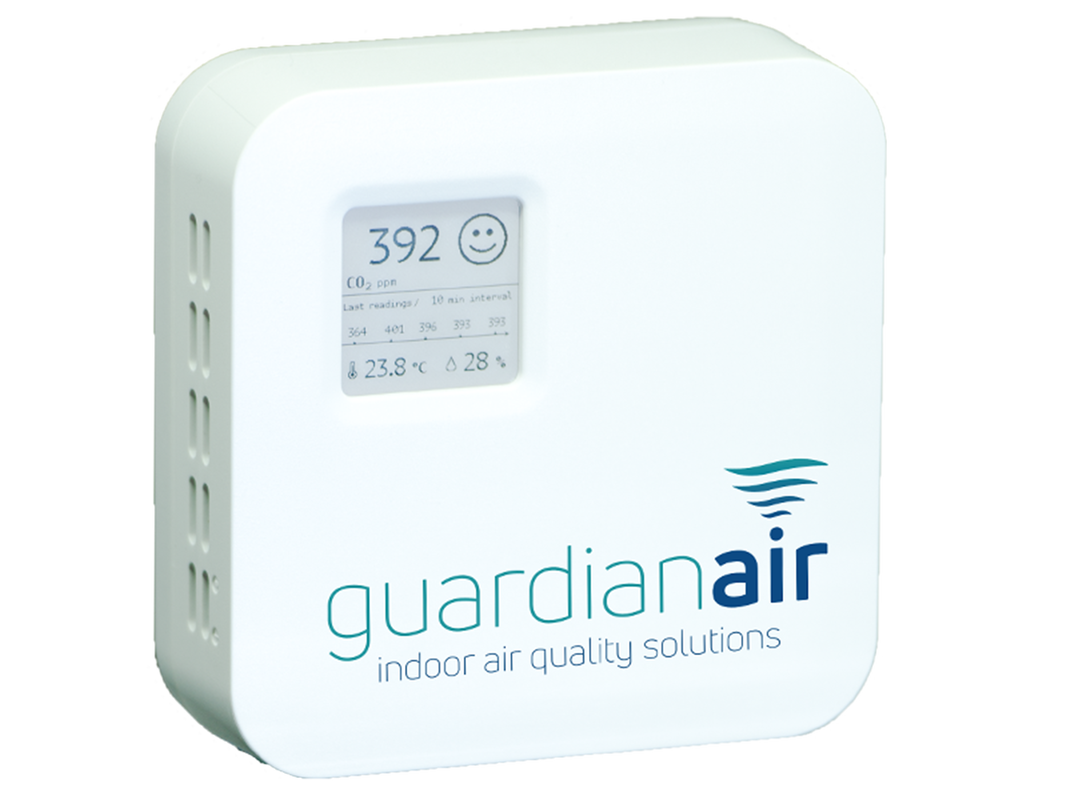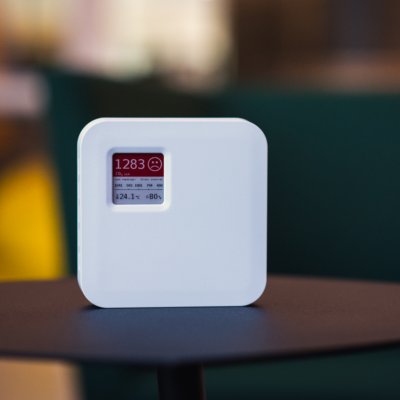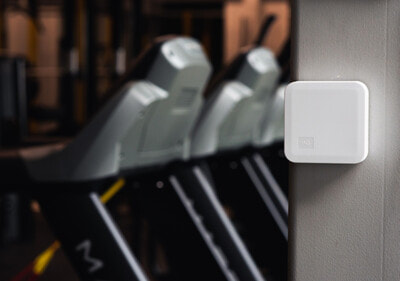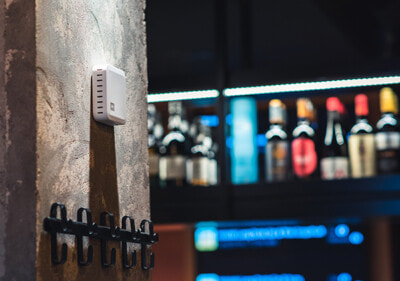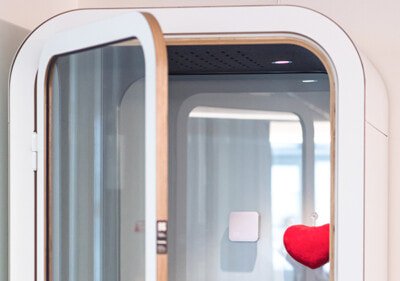Infinity IoT uses smart devices to measure the indoor air quality in buildings and deliver data-driven, actionable insights to benefit everyone concerned with the health and wellbeing of building occupants. Infinity IoT has developed a range of solutions that measure Carbon Dioxide, Volatile Organic Compounds, Particulate Matter, Temperature and Humidity in rooms and export the data via user friendly portal.
Indoor air quality monitoring has rarely been as important as it is today, and our personalized, cloud-based solution is simple to install, easy to understand and adds great value to businesses seeking sustainability certification, or a stronger Employee Value Proposition. Infinity IoT fully installs the equipment at no cost, with no hidden fees or maintenance charges. Clients pay a simple monthly subscription to Infinity IoT, who will collect, process and display the data gathered, with reports configured to the clients’ requirements.
Indoor air quality monitoring has rarely been as important as it is today, and our personalized, cloud-based solution is simple to install, easy to understand and adds great value to businesses seeking sustainability certification, or a stronger Employee Value Proposition. Infinity IoT fully installs the equipment at no cost, with no hidden fees or maintenance charges. Clients pay a simple monthly subscription to Infinity IoT, who will collect, process and display the data gathered, with reports configured to the clients’ requirements.
Guardian Air monitors CO2, PM, VOC, temperature and humidity using our state-of-the-art battery operated sensors (five to seven years battery life).
Guardian Air Indoor Air Quality Solutions monitors indoor air quality to determine the risk associated with indoor air pathogens. This real-time data puts the power in your hands 24/7. Indoor Air Quality assessment and ongoing monitoring is a worldwide service offering that is now available in South Africa for business, staff, and customer peace of mind.
IAQ is an internationally recognised metric for Indoor Air Quality that is used by scientists, environmentalists, government departments, industry sectors, and indoor air quality monitoring service providers and partners. Guardian Air Solutions has recently been established to offer a solution to the growing need for continuous risk assessment and monitoring of indoor air quality. Servicing the South African market with professional insight, a dedicated team for ongoing support and a tried and tested international wireless monitoring system that offers real-time data, alerts and more...
The recent pandemic has highlighted the necessity for business owners, facilities managers and all who serve the public in indoor spaces to take responsibility and efficiently monitor the risk associated with poor Indoor Air Quality. An efficient monitoring system will alert responsible citizens who will then be able to take action and effect change in the ventilation and achieve acceptable Indoor Air Quality for health, wellbeing and performance.
The recent pandemic has highlighted the necessity for business owners, facilities managers and all who serve the public in indoor spaces to take responsibility and efficiently monitor the risk associated with poor Indoor Air Quality. An efficient monitoring system will alert responsible citizens who will then be able to take action and effect change in the ventilation and achieve acceptable Indoor Air Quality for health, wellbeing and performance.
How does it work?
See the air you breathe
Your right to breathe healthy air - PLEASE READ THIS - IT'S ABOUT YOU
We all have a very high level of control over what we eat and drink. But when it comes to the air we breathe, we have virtually none. And yet, adults breathe around 11,000-17,000 litres of air per day, depending on activity. We should know about what we breathe, especially when we’re indoors and have no alternative but to breathe the air we’re supplied with.
There is now much evidence* that polluted air causes major health problems; it inhibits the physical and mental development of children and can even bring about premature death. It has a direct impact on our short- and long-term health and the way our brains and bodies perform.
So when you’re at work or having a workout at your favourite gym, or in your local supermarket how do you know if you’re being supplied with unpolluted air? You don’t – because the quality of the air is almost certainly not being monitored for pollutants.
Your employers or your gym manager might say “Well, we’ve never had any complaints” – but that’s not the point! They don’t know if the air you are forced to breathe in those buildings contains pollutants or not.
For example, without monitoring, no one would know if the air in a city office is polluted with harmful particulates, volatile organic compounds and high levels of carbon dioxide. And in a crowded gym, the carbon dioxide levels can rise dramatically making your body and lungs work hard to extract oxygen from carbon dioxide laden air.
Arguably, employers have a responsibility to supply healthy air to their employees. The only way they can prove that they are fulfilling that obligation is to monitor the air and display the data on the video screens and/or their website.
And without monitoring indoor air quality how can schools reassure you that the indoor air your children breathe is healthy?
Healthy air? It’s your right.
There is now much evidence* that polluted air causes major health problems; it inhibits the physical and mental development of children and can even bring about premature death. It has a direct impact on our short- and long-term health and the way our brains and bodies perform.
So when you’re at work or having a workout at your favourite gym, or in your local supermarket how do you know if you’re being supplied with unpolluted air? You don’t – because the quality of the air is almost certainly not being monitored for pollutants.
Your employers or your gym manager might say “Well, we’ve never had any complaints” – but that’s not the point! They don’t know if the air you are forced to breathe in those buildings contains pollutants or not.
For example, without monitoring, no one would know if the air in a city office is polluted with harmful particulates, volatile organic compounds and high levels of carbon dioxide. And in a crowded gym, the carbon dioxide levels can rise dramatically making your body and lungs work hard to extract oxygen from carbon dioxide laden air.
Arguably, employers have a responsibility to supply healthy air to their employees. The only way they can prove that they are fulfilling that obligation is to monitor the air and display the data on the video screens and/or their website.
And without monitoring indoor air quality how can schools reassure you that the indoor air your children breathe is healthy?
Healthy air? It’s your right.
Technical Specs
|
PM1 / PM2.5 / PM10 Sensors
0.3~1.0; 1.0~2.5; 2.5~10 μm
Effective Range : 0~1000 μg/m3 Resolution : 1 μg/m3 Accuracy : ±15% Sensor : Sensirion SPS30 Measurement Principle : laser scattering |
Temperature Sensor and Humidity
Range : -20 - 50°C
Resolution : 0.1 °C Accuracy : ±0.2 °C Range : 0-95 %RH Resolution : 0.1 %RH Accuracy : ±2 %RH Sensor : Sensirion SHTC3 |
Choose your unit
For everyone
Our live Indoor Air Quality (IAQ) Monitoring and Alerting System which is a highly scalable solution which can be used in 1 building or 100 buildings worldwide. SMART simplifies air quality monitoring and alerting and provides the tools to establish safer indoor spaces for everyone.
All the data you need to reduce virus risk
Be equipped with the power of knowing exactly what to do to fight viruses indoors, so you can rest easy knowing your air is optimized for health and safety. COVID-19 has forced people around the world to stay indoors. Good indoor air quality is now paramount for your own healthy and well-being. Research has proven the correlation between air quality and the coronavirus. Utilizing air quality data within your home and workplace allows you to create the best possible environment to deactivate viruses.With Guardian Air, you’ll be able to do exactly that – make better decisions about your health with the help of accurate air quality data.
Offices
With good indoor air quality, you can improve productivity, reduce health-related complaints and absenteeism due to sick leave, and create a safe, healthy and comfortable office for your employees.
Most working people spend at least 30% of their day inside the office. This means that at least a third of their day is spent being exposed to invisible elements in the workplace caused by various pollutant sources such as emissions from office equipment, cleaning products, new furnishings, building materials, and in many cases poorly-maintained HVAC systems. If not addressed, this can lead to health problems such as headaches, fatigue, respiratory ailments, resulting in decline in productivity and increased sick days for employees. Moreover, studies show that indoor air quality has a significant impact on the cognitive performance of workers.
Employers have the responsibility to ensure a healthy, safe and comfortable working environment, and employees have the basic right to breathe healthy air.
Managing your indoor air quality starts with understanding the air you’re breathing so that you can take the proper actions to create a healthy office environment for your employees. By regularly monitoring your indoor air quality, you can have better insights about the different air quality factors in relation to your employees and make better decisions to optimize your office environment.
Most working people spend at least 30% of their day inside the office. This means that at least a third of their day is spent being exposed to invisible elements in the workplace caused by various pollutant sources such as emissions from office equipment, cleaning products, new furnishings, building materials, and in many cases poorly-maintained HVAC systems. If not addressed, this can lead to health problems such as headaches, fatigue, respiratory ailments, resulting in decline in productivity and increased sick days for employees. Moreover, studies show that indoor air quality has a significant impact on the cognitive performance of workers.
Employers have the responsibility to ensure a healthy, safe and comfortable working environment, and employees have the basic right to breathe healthy air.
Managing your indoor air quality starts with understanding the air you’re breathing so that you can take the proper actions to create a healthy office environment for your employees. By regularly monitoring your indoor air quality, you can have better insights about the different air quality factors in relation to your employees and make better decisions to optimize your office environment.
Commercial
Indoor air quality is a major concern for commercial building owners because of its impact on the health, comfort, and well-being of tenants and customers. Poor indoor air quality affects tenant health, leading to illness and even death. Asthma and other allergic reactions can be caused by exposure to various pollutants such as particulate matter, gases, and microorganisms in the air.
Moreover, harmful airborne agents such as the coronavirus cause infection as a result of inhaling the organism. Control of indoor air quality is therefore critical to protecting tenants from such infections.
With poor indoor air quality, productivity is also compromised. The effect ranges from the impact on absences, discomfort, and reduced cognitive performance to long-term illnesses such as lung cancer, cardiovascular morbidity, and heart diseases to name a few. This leads to significant economic costs ranging from health care, lost time and productivity, lost rents, lost commercial opportunities aside from legal implications to the building management.
In commercial buildings, keeping the indoor air quality healthy creates a good business ecosystem both for the building owner as well as its tenants. Good indoor air quality helps in marketing commercial real estate. Conversely, litigations and complaints about poor indoor air quality may damage the marketability of a property.
A key to managing the complex and challenging process of efficiently operating buildings to provide a safe and comfortable environment lies in the ability to utilize air quality information for useful insights that can guide decision making – from building design to effective day-to-day operations. Indoor air quality monitoring can address not only the identification and control of the sources of indoor air issues but also in managing HVAC systems to maintain comfort as well as in verifying your building’s environmental performance.environmental performance.
Moreover, harmful airborne agents such as the coronavirus cause infection as a result of inhaling the organism. Control of indoor air quality is therefore critical to protecting tenants from such infections.
With poor indoor air quality, productivity is also compromised. The effect ranges from the impact on absences, discomfort, and reduced cognitive performance to long-term illnesses such as lung cancer, cardiovascular morbidity, and heart diseases to name a few. This leads to significant economic costs ranging from health care, lost time and productivity, lost rents, lost commercial opportunities aside from legal implications to the building management.
In commercial buildings, keeping the indoor air quality healthy creates a good business ecosystem both for the building owner as well as its tenants. Good indoor air quality helps in marketing commercial real estate. Conversely, litigations and complaints about poor indoor air quality may damage the marketability of a property.
A key to managing the complex and challenging process of efficiently operating buildings to provide a safe and comfortable environment lies in the ability to utilize air quality information for useful insights that can guide decision making – from building design to effective day-to-day operations. Indoor air quality monitoring can address not only the identification and control of the sources of indoor air issues but also in managing HVAC systems to maintain comfort as well as in verifying your building’s environmental performance.environmental performance.
Industrial
Indoor air quality is a critical concern in manufacturing facilities. Continuous exposure to nitrogen dioxide, carbon monoxide, and other air pollutants can severely impact the health and productivity of workers. In airtight warehouse and manufacturing facilities with high humidity and suboptimal fresh air exchange, workers are continuously exposed to a number of dangerous and toxic substances that are circulating in the air. This causes illnesses ranging from asthma and headaches to life-threatening ones like lung cancer and heart ailments. Moreover, studies provide strong evidence for the survival and transmission of airborne infectious pathogens – such as the coronavirus – in poorly ventilated and closed environments.
Poor indoor air quality significantly increases costs for business owners. Aside from workers being at risk of getting sick which leads to increased health care costs, there’s also loss of income due to lack of manpower resulting from absences and turnover. Delayed processes are caused by equipment downtime as dust, mold and bacteria thrive in the HVAC and manufacturing equipment. As owners are responsible to protect the health, safety and wellbeing of the workers, IAQ-related litigations could be potentially damaging to the company.
A healthy work environment is an excellent investment. Ensuring good indoor air quality significantly improves workers’ job satisfaction and productivity. Research has shown that spending just $40 per person a year on IAQ results in a $6,500 increase in employee output. It also promotes the operational reliability of manufacturing and HVAC systems and equipment.
Take control of your indoor air quality by understanding the sources of pollutants in relation to your operations. With real-time monitoring you can identify specific issues, get alerted to urgent situations that need attention, and take the proper course of action to optimize the utilization of your facility and the performance of your workers.
Poor indoor air quality significantly increases costs for business owners. Aside from workers being at risk of getting sick which leads to increased health care costs, there’s also loss of income due to lack of manpower resulting from absences and turnover. Delayed processes are caused by equipment downtime as dust, mold and bacteria thrive in the HVAC and manufacturing equipment. As owners are responsible to protect the health, safety and wellbeing of the workers, IAQ-related litigations could be potentially damaging to the company.
A healthy work environment is an excellent investment. Ensuring good indoor air quality significantly improves workers’ job satisfaction and productivity. Research has shown that spending just $40 per person a year on IAQ results in a $6,500 increase in employee output. It also promotes the operational reliability of manufacturing and HVAC systems and equipment.
Take control of your indoor air quality by understanding the sources of pollutants in relation to your operations. With real-time monitoring you can identify specific issues, get alerted to urgent situations that need attention, and take the proper course of action to optimize the utilization of your facility and the performance of your workers.
Hotels
Good air quality in hotels is more than an amenity, it’s a necessity. Guests expect a comfortable and healthy indoor environment. This could be challenging as hotels are typically built as closed air-tight environments which can potentially be a breeding ground for viruses and bacteria. Keeping your guests healthy and comfortable means not only providing clean bedsheets and fresh-smelling rooms but also ensuring that the air they are breathing is free from anything that could potentially make them sick.
Poor indoor air quality also impacts the health and productivity of employees. When employees who are exposed to indoor air pollutants suffer from symptoms such as headaches, fatigue, or respiratory conditions, this could lead to reduced work efficiency, increased absenteeism, and higher healthcare costs for the hotel. With poor air quality conditions, viruses also remain longer in the air and can spread more quickly among employees and guests. Providing a good indoor environment with optimal air quality is not only a health concern, it is a legal and business liability concern.
Guests who are satisfied and comfortable during their stay are likely to return and leave positive recommendations which can bolster the hotel’s image. In an industry where perception can significantly impact revenues, taking control of indoor air quality issues to ensure a healthy and safe environment for your guests and employees may help hotel owners to regain their competitive edge. Having a comprehensive indoor air quality management plan – with real-time data that can be shared with guests and employees – can help ease fears and anxieties and instill confidence in returning to hotels.
Poor indoor air quality also impacts the health and productivity of employees. When employees who are exposed to indoor air pollutants suffer from symptoms such as headaches, fatigue, or respiratory conditions, this could lead to reduced work efficiency, increased absenteeism, and higher healthcare costs for the hotel. With poor air quality conditions, viruses also remain longer in the air and can spread more quickly among employees and guests. Providing a good indoor environment with optimal air quality is not only a health concern, it is a legal and business liability concern.
Guests who are satisfied and comfortable during their stay are likely to return and leave positive recommendations which can bolster the hotel’s image. In an industry where perception can significantly impact revenues, taking control of indoor air quality issues to ensure a healthy and safe environment for your guests and employees may help hotel owners to regain their competitive edge. Having a comprehensive indoor air quality management plan – with real-time data that can be shared with guests and employees – can help ease fears and anxieties and instill confidence in returning to hotels.
RESTAURANTS
Poor indoor air quality is a significant concern for restaurants, especially at a time when health is foremost in everyone’s minds. Aside from good hygiene and sanitation, there is now a critical need to ensure safety for the customers and employees. Studies show a number of coronavirus outbreak cases can be traced to indoor spaces with poor air quality issues such as restaurants. Harmful pollutants, inadequate ventilation and high or low humidity and temperature can cause health symptoms such as dizziness, headaches, nausea and a general feeling of discomfort.
Providing a high-quality dining experience is not just about the quality of the food. When customers are hesitant to dine in restaurants and employees complain of feeling sick while working, restaurants need to step up their game when it comes to health and safety standards, which includes improving indoor air quality.
By optimizing air quality, restaurants can ease customers’ anxiety over the risk of virus exposure and transmission while providing a safe and comfortable environment for the staff. As customers look for clear evidence that the restaurant is a safe place where they can enjoy themselves, owners can leverage on this by sharing information about their indoor air quality practices that signifies their commitment to providing a clean, safe, and comfortable environment.
In this new era, businesses that understand how to keep customers safe – and effectively communicate their efforts – will be the ones who win.
Providing a high-quality dining experience is not just about the quality of the food. When customers are hesitant to dine in restaurants and employees complain of feeling sick while working, restaurants need to step up their game when it comes to health and safety standards, which includes improving indoor air quality.
By optimizing air quality, restaurants can ease customers’ anxiety over the risk of virus exposure and transmission while providing a safe and comfortable environment for the staff. As customers look for clear evidence that the restaurant is a safe place where they can enjoy themselves, owners can leverage on this by sharing information about their indoor air quality practices that signifies their commitment to providing a clean, safe, and comfortable environment.
In this new era, businesses that understand how to keep customers safe – and effectively communicate their efforts – will be the ones who win.
schools
Indoor air quality in schools is a significant concern. Children are considered more susceptible to air pollutants because they breathe a greater volume of air in relation to their body weight. They also spend more time in indoor environments such as classrooms and daycare facilities where they are in close proximity to other people.
Research has shown that infectious pathogens such as the coronavirus are more likely to survive and get transmitted through the air in indoor environments where there is high humidity and reduced ventilation. There is a strong correlation between the concentrations of the pollutants and onset or aggravation of health problems in schoolchildren – from headaches to asthma, cancer, and even developmental delays. Studies have also associated poor indoor air quality with a decrease in students’ ability to perform specific mental tasks requiring concentration and memory. Discomfort can cause irritability and other behavioral problems.
School administrators have the responsibility to provide a favorable learning environment for students, productivity and wellbeing for teachers and staff, and a sense of comfort and health for all. Parents expect the schools to employ utmost care and protection for their children while they are at school. Failure to ensure good indoor air quality not only impacts on student and staff absenteeism, decreased learning performance but also serious complaints and legal issues for the school.
Maintaining good indoor air quality starts with knowing the air that your students and staff are breathing in. Take control by understanding the different pollutants and their sources so you can prioritize which issues to address and create a plan to eliminate the risks for your students and staff. Insights from real-time monitoring and identification of air quality issues can be shared with parents and staff to ease their worries and give them confidence that the school is a safe place for their children.
Research has shown that infectious pathogens such as the coronavirus are more likely to survive and get transmitted through the air in indoor environments where there is high humidity and reduced ventilation. There is a strong correlation between the concentrations of the pollutants and onset or aggravation of health problems in schoolchildren – from headaches to asthma, cancer, and even developmental delays. Studies have also associated poor indoor air quality with a decrease in students’ ability to perform specific mental tasks requiring concentration and memory. Discomfort can cause irritability and other behavioral problems.
School administrators have the responsibility to provide a favorable learning environment for students, productivity and wellbeing for teachers and staff, and a sense of comfort and health for all. Parents expect the schools to employ utmost care and protection for their children while they are at school. Failure to ensure good indoor air quality not only impacts on student and staff absenteeism, decreased learning performance but also serious complaints and legal issues for the school.
Maintaining good indoor air quality starts with knowing the air that your students and staff are breathing in. Take control by understanding the different pollutants and their sources so you can prioritize which issues to address and create a plan to eliminate the risks for your students and staff. Insights from real-time monitoring and identification of air quality issues can be shared with parents and staff to ease their worries and give them confidence that the school is a safe place for their children.
healthcare
Healthcare facilities like hospitals are held to a higher standard when it comes to indoor air quality. Hospitals are expected to protect patients and healthcare workers from hospital-acquired infections (HAIs) and other occupational illnesses. Due to the nature of its operations, hospitals are breeding grounds for airborne pathogens that could potentially cause infections and outbreaks.
Hospitals are required to comply with regulatory standards on specific air quality factors such as ventilation rate, temperature, and humidity level among others. But hospitals need to go beyond “code-minimum” when it comes to ensuring an environment that is safe, healthy, and comfortable for its patients and healthcare staff. Failure to do so not only poses serious health consequences but also affects the productivity of the staff, compromises the hospital’s reputation and its ability to get funding and increase HAI-related complaints and legal actions. Poor indoor air quality can also impact on the performance of the hospital’s critical equipment and systems, as maintenance and repair can lead to delays in procedures.
The old adage, “an ounce of prevention is worth a pound of cure,” holds true for hospitals when it comes to indoor air quality management. By understanding the components that can impact indoor air quality, hospital administrators can properly design and develop a process to ensure that pollutants contributing to poor indoor air quality are taken into consideration and thus minimized. With good indoor air quality, doctors and nurses are kept healthy, able to provide the best care to their patients, which leads to a reduction of hospital-acquired infections, shortened patient recovery time, and lower mortality rate.
Hospitals are required to comply with regulatory standards on specific air quality factors such as ventilation rate, temperature, and humidity level among others. But hospitals need to go beyond “code-minimum” when it comes to ensuring an environment that is safe, healthy, and comfortable for its patients and healthcare staff. Failure to do so not only poses serious health consequences but also affects the productivity of the staff, compromises the hospital’s reputation and its ability to get funding and increase HAI-related complaints and legal actions. Poor indoor air quality can also impact on the performance of the hospital’s critical equipment and systems, as maintenance and repair can lead to delays in procedures.
The old adage, “an ounce of prevention is worth a pound of cure,” holds true for hospitals when it comes to indoor air quality management. By understanding the components that can impact indoor air quality, hospital administrators can properly design and develop a process to ensure that pollutants contributing to poor indoor air quality are taken into consideration and thus minimized. With good indoor air quality, doctors and nurses are kept healthy, able to provide the best care to their patients, which leads to a reduction of hospital-acquired infections, shortened patient recovery time, and lower mortality rate.
government
While governments may have measures in place to monitor and regulate outdoor air pollution, the same thing cannot be said about indoor air pollution – an issue that has largely taken a backseat in the past when it comes to promoting public health. The coronavirus pandemic has changed this as people are forced to stay indoors.
Communities thrive when citizens are safe, healthy, and productive. As institutions of authority, government offices need to lead by example in creating an environment that is safe and healthy. They should be able to set the standards on how workplaces should operate.
Modeling healthy and safe government offices signifies a commitment to prioritizing the wellbeing of the employees in the offices as well as the public served by these offices. Having a data-driven indoor air quality management system can also help in the formulation of policies that would impact on a much wider scale and provide solutions to protect citizens from the negative impacts of indoor air pollution.
Communities thrive when citizens are safe, healthy, and productive. As institutions of authority, government offices need to lead by example in creating an environment that is safe and healthy. They should be able to set the standards on how workplaces should operate.
Modeling healthy and safe government offices signifies a commitment to prioritizing the wellbeing of the employees in the offices as well as the public served by these offices. Having a data-driven indoor air quality management system can also help in the formulation of policies that would impact on a much wider scale and provide solutions to protect citizens from the negative impacts of indoor air pollution.
airports
Airports are evolving from being mere transportation hubs to standalone visitor destinations and tourism showpieces for governments. As such, airport managers are faced with the increasing challenge of creating value and providing an experience to passengers that will differentiate them from competitors.
However, that is not the only challenge that they are dealing with. Many of the activities that are performed in airports contribute to outdoor and indoor air pollution – from vehicular emissions of taxis, buses and private vehicles to airside operations like refueling, landing and take-off cycles among others. Exposure to various pollutants such as carbon monoxide, nitrogen oxide, formaldehyde, sulfur dioxide and particulate matter can result in significant health problems for passengers and airport personnel.
Moreover, airports can be potential hotbeds for coronavirus transmission. With tens of millions of passengers and visitors who enter and spend time inside airports, the possibility of infection increases. With various studies on the link between air quality and the spread of viruses, it becomes crucial to manage indoor air quality in public spaces like airports.
As part of an overall indoor environmental quality management strategy, monitoring of air quality performance can provide operational and passenger benefits to an airport. With real-time and accurate air quality data, airport managers can identify critical sources of problems so they can promptly address them. Having a centralized view of all the locations in the airport in one dashboard and integration with the HVAC and building systems simplifies management and control to ensure optimal indoor air quality.
Creating a healthy and safe airport environment improves the health and well-being of airport and airline partners’ staff. More importantly, it enhances not only passenger experience but also confidence in travel.
However, that is not the only challenge that they are dealing with. Many of the activities that are performed in airports contribute to outdoor and indoor air pollution – from vehicular emissions of taxis, buses and private vehicles to airside operations like refueling, landing and take-off cycles among others. Exposure to various pollutants such as carbon monoxide, nitrogen oxide, formaldehyde, sulfur dioxide and particulate matter can result in significant health problems for passengers and airport personnel.
Moreover, airports can be potential hotbeds for coronavirus transmission. With tens of millions of passengers and visitors who enter and spend time inside airports, the possibility of infection increases. With various studies on the link between air quality and the spread of viruses, it becomes crucial to manage indoor air quality in public spaces like airports.
As part of an overall indoor environmental quality management strategy, monitoring of air quality performance can provide operational and passenger benefits to an airport. With real-time and accurate air quality data, airport managers can identify critical sources of problems so they can promptly address them. Having a centralized view of all the locations in the airport in one dashboard and integration with the HVAC and building systems simplifies management and control to ensure optimal indoor air quality.
Creating a healthy and safe airport environment improves the health and well-being of airport and airline partners’ staff. More importantly, it enhances not only passenger experience but also confidence in travel.
gyms
As facilities that promote health and wellness, gyms need to provide an environment with good indoor air quality so clients can feel comfortable and safe to work out.
However, this is easier said than done. The unique characteristics of gyms and other fitness studios already present a range of potential air quality concerns – small and enclosed rooms, intense indoor activities, and the number of people at any given time who are exhaling a higher amount of carbon dioxide. As people breathe more heavily, CO2 levels in the room significantly increase and oxygen levels decrease which can make it difficult for clients to breathe and cause them to feel discomfort and fatigue.
Add subpar gym ventilation to the mix and you now have a scenario where clients are likely to experience other symptoms due to exposure to high humidity, uncontrolled temperatures, unpleasant odors, and harmful pathogens in the air. Clients go to gyms to improve their health or maintain it through exercise. Poor indoor air quality does not promote good health and this can drive clients away.
Moreover, it increases the risk of survival and transmission of COVID-19.
Healthy air is critical for a healthy gym. Owners and managers can certainly adopt a number of ways to make their facilities safer. However, it needs to start with a careful and thorough assessment of the various factors that affect indoor air quality in order to address the issues and optimize the benefits of healthy physical activities for the clients. Monitoring and measuring key factors such as carbon dioxide, temperature, humidity, carbon monoxide, particulate matter, and volatile organic compounds can go a long way in managing indoor air quality to create a safe and healthy fitness studio.
However, this is easier said than done. The unique characteristics of gyms and other fitness studios already present a range of potential air quality concerns – small and enclosed rooms, intense indoor activities, and the number of people at any given time who are exhaling a higher amount of carbon dioxide. As people breathe more heavily, CO2 levels in the room significantly increase and oxygen levels decrease which can make it difficult for clients to breathe and cause them to feel discomfort and fatigue.
Add subpar gym ventilation to the mix and you now have a scenario where clients are likely to experience other symptoms due to exposure to high humidity, uncontrolled temperatures, unpleasant odors, and harmful pathogens in the air. Clients go to gyms to improve their health or maintain it through exercise. Poor indoor air quality does not promote good health and this can drive clients away.
Moreover, it increases the risk of survival and transmission of COVID-19.
Healthy air is critical for a healthy gym. Owners and managers can certainly adopt a number of ways to make their facilities safer. However, it needs to start with a careful and thorough assessment of the various factors that affect indoor air quality in order to address the issues and optimize the benefits of healthy physical activities for the clients. Monitoring and measuring key factors such as carbon dioxide, temperature, humidity, carbon monoxide, particulate matter, and volatile organic compounds can go a long way in managing indoor air quality to create a safe and healthy fitness studio.



